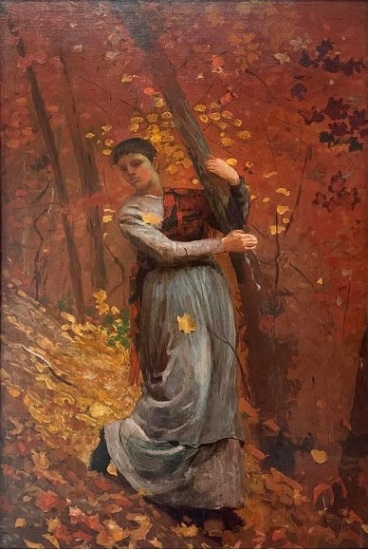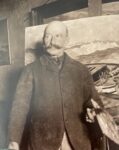
Winslow Homer
American, 1836-1910
Woman in Autumn Woods, 1877 ca.
oil on canvas
35 1/8 × 24 in.
SBMA, Gift of Mrs. Sterling Morton to the Preston Morton Collection
1960.63

Winslow Homer, Bowdoin College Museum of Art, Brunswick, Maine
RESEARCH PAPER
Winslow Homer was one of the most famous late 19th century American Realist painters, best known for his watercolors of marine scenes and seascapes.
In looking at line, we see a steep left to right diagonal, cut by a vertical line of the figure of the woman and the trees. Shapes and forms in the painting include the hillside, the trees, and the woman. The space is filled with color and light. Leaves fill nearly every empty space, and her head is encircled with a halo of golden leaves, which capture and reflect the light.
As for color, Homer uses a warm palette of orange, reds, warm brown and gold, contrasted with the woman’s figure in a blue dress and apron. A shawl in an even deeper shade of red is over her left shoulder, seeming to mimic the pattern of the falling leaves and providing another texture to the scene.
The light comes from the right and strikes her cheek and hands as they wrap around the trunk of the tree and the light is further reflected in the gold of the swirling leaves around her head and in the air behind her.
Winslow Homer was born in Boston in 1836 and raised near Cambridge, Massachusetts, where his mother was a skilled amateur watercolorist and his first teacher. As a young man, he made his living as a commercial printmaker and moved from Boston to New York in 1859 to take a position as an artist and cartographer for the new “Harper’s Weekly” newsmagazine. In 1861 Harper’s sent Homer to Virginia as a war artist-correspondent to cover the battles of the Civil War. He completed various prints, drawing and oil paintings of Civil War battles and scenes of wartime life for the publication. Following the war he went to France in 1866 where two of his oil paintings from the War were exhibited in the Exposition Universelle in Paris. He spent 10 months in France, where he was exposed to paintings of the Barbizon School and French Impressionist works. He shared Monet’s interests in subject matter, serial imagery, outdoor light, and free brushwork but felt a greater affinity with the French Barbizon School and the works of Millet.
After the war Homer turned his attention primarily to scenes of childhood and young women in village life, reflecting nostalgia for simpler times, both his own and that of the nation as a whole. By 1875, the success of his oil paintings enabled him to commit to painting full time and leave his position with Harper’s.
During the 1870’s, he frequently depicted women and children in domestic scenes out of doors, as in this work. His subjects are unknown, as his focus was on depicting color and light rather than constructing a narrative.
While we might observe some influence of Impressionism in his treatment of the background and the golden leaves at her feet, the figure is rendered in a Realistic style.
The mood of the painting is pensive. She seems thoughtful as she pauses on her walk. Perhaps she is struck by the natural melancholy of the Autumn season. This poignant scene brings to mind a poem by John Keats, “Ode to Autumn”, 1820, which mirrors the pensive mood.
“Where are the songs of Spring? Ay, Where are they?
Think not of them, thou hast thy music too, ---
While barred clouds bloom the soft-dying day,
And touch the stubble plains with rosy hue.
Then in a wailful choir the small gnats mourn
Among the river sallows, borne aloft
Or sinking as the light wind lives or dies;
And full-grown lambs loud bleat from hilly bourn;
Hedge-crickets sing; and now with treble soft
The red-breast whistles from a garden-croft;
And gathering swallows twitter in the skies.”
Prepared for the SBMA Docent Council by Mary Benedict, February, 2023
Bibliography
Books:
Getlein, Mark; Living With Art: Twelfth Edition; McGraw Hill Education, New York, NY; 2020
Herdrich, Stephanie L. and Yount, Sylvia; Winslow Homer Crosscurrents; The Metropolitan Museum of Art, New York, NY; 2022
Kelly, Franklin, with Cikovsey, Nicolai, Chotner, Deborah and Davis, John; American Painting of the Nineteenth Century: Part 1; Pages 318-321; National Gallery of Art, Washington, D.C. and Oxford University Press, New York, NY; 1996.
Online Sources:
The Poetry Foundation – John Keats, “Ode to Autumn”, 1820
https://www.poetryfoundation.org/poems/44484/toautumn
Santa Barbara Museum of Art website –
https://collections.sbma.net/objects/1596/woman-in-autumn-woods
SBMA CURATORIAL LABELS
One of the most famous late 19th century American artists, Winslow Homer is best known for his paintings of marine scenes and his work as a groundbreaking watercolorist. After an early career as a lithographer and illustrator for Harper’s Weekly, where he worked as an artist-correspondent covering the front lines of the Civil War, Homer began working in oil paint after the war. His work was quickly recognized for his clarity, realism, and un-sentimental approach to depicting American
life.
This painting dates from the middle years of Homer’s career, when he continued to develop his unique oil painting style and began to experiment with watercolor. Many of his paintings from this period depict women taking part in various genteel activities, from strolling on the beach to playing croquet. As in this painting, the individual subjects remain unknown and Homer’s interest was in exploring the formal elements of light and color rather than constructing a narrative.
Woman in Autumn Woods is thought to have been painted on one of Homer’s many trips to the countryside outside New York City, possibly at Houghton Farm, the home of a family friend where Winslow would often spend time with his brother Charles and his sister-in-law. The deep rust hues of the autumn leaves clearly offered the artist an opportunity to experiment with color, and his more spontaneous and expressive paint handling shows his interest in capturing fleeting impressions of nature. Although Homer would have encountered Impressionism during his trip to Paris from 1866-67, his work always followed his own approach to color and light, featuring more solidly realized figures.
- Ludington Court Reopening, 2021
